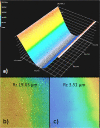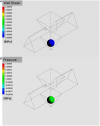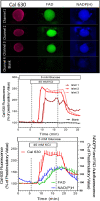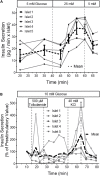A Parallel Perifusion Slide From Glass for the Functional and Morphological Analysis of Pancreatic Islets
- PMID: 33763408
- PMCID: PMC7982818
- DOI: 10.3389/fbioe.2021.615639
A Parallel Perifusion Slide From Glass for the Functional and Morphological Analysis of Pancreatic Islets
Abstract
An islet-on-chip system in the form of a completely transparent microscope slide optically accessible from both sides was developed. It is made from laser-structured borosilicate glass and enables the parallel perifusion of five microchannels, each containing one islet precisely immobilized in a pyramidal well. The islets can be in inserted via separate loading windows above each pyramidal well. This design enables a gentle, fast and targeted insertion of the islets and a reliable retention in the well while at the same time permitting a sufficiently fast exchange of the media. In addition to the measurement of the hormone content in the fractionated efflux, parallel live cell imaging of the islet is possible. By programmable movement of the microscopic stage imaging of five wells can be performed. The current chip design ensures sufficient time resolution to characterize typical parameters of stimulus-secretion coupling. This was demonstrated by measuring the reaction of the islets to stimulation by glucose and potassium depolarization. After the perifusion experiment islets can be removed for further analysis. The live-dead assay of the removed islets confirmed that the process of insertion and removal was not detrimental to islet structure and viability. In conclusion, the present islet-on-chip design permits the practical implementation of parallel perifusion experiments on a single and easy to load glass slide. For each immobilized islet the correlation between secretion, signal transduction and morphology is possible. The slide concept allows the scale-up to even higher degrees of parallelization.
Keywords: NAD(P)H- and FAD-autofluorescence; borosilicate glass; calcium; femtosecond laser-structuring; insulin secretion; islet of langerhans; microfluidic perifusion system.
Copyright © 2021 Schulze, Mattern, Erfle, Brüning, Scherneck, Dietzel and Rustenbeck.
Conflict of interest statement
The authors declare that the research was conducted in the absence of any commercial or financial relationships that could be construed as a potential conflict of interest.
Figures













Similar articles
-
A 3D microfluidic perfusion system made from glass for multiparametric analysis of stimulus-secretioncoupling in pancreatic islets.Biomed Microdevices. 2017 Sep;19(3):47. doi: 10.1007/s10544-017-0186-z. Biomed Microdevices. 2017. PMID: 28540469
-
A Microfluidic Hanging-Drop-Based Islet Perifusion System for Studying Glucose-Stimulated Insulin Secretion From Multiple Individual Pancreatic Islets.Front Bioeng Biotechnol. 2021 May 12;9:674431. doi: 10.3389/fbioe.2021.674431. eCollection 2021. Front Bioeng Biotechnol. 2021. PMID: 34055765 Free PMC article.
-
Dynamic perifusion to maintain and assess isolated pancreatic islets.Diabetes Technol Ther. 2002;4(1):67-76. doi: 10.1089/15209150252924111. Diabetes Technol Ther. 2002. PMID: 12017423
-
Structure-function relationships in pancreatic islets: support for intraislet modulation of insulin secretion.Endocrinology. 1985 Nov;117(5):2073-80. doi: 10.1210/endo-117-5-2073. Endocrinology. 1985. PMID: 2864239
-
Application of microfluidic technology to pancreatic islet research: first decade of endeavor.Bioanalysis. 2010 Oct;2(10):1729-44. doi: 10.4155/bio.10.131. Bioanalysis. 2010. PMID: 21083325 Review.
Cited by
-
PlateFlo - A software-controllable plate-scale perfusion system for culture of adherent cells.HardwareX. 2021 Aug 11;10:e00222. doi: 10.1016/j.ohx.2021.e00222. eCollection 2021 Oct. HardwareX. 2021. PMID: 35607664 Free PMC article.
-
What Is the Metabolic Amplification of Insulin Secretion and Is It (Still) Relevant?Metabolites. 2021 Jun 2;11(6):355. doi: 10.3390/metabo11060355. Metabolites. 2021. PMID: 34199454 Free PMC article. Review.
-
Investigation of the Exometabolomic Profiles of Rat Islets of Langerhans Cultured in Microfluidic Biochip.Metabolites. 2022 Dec 15;12(12):1270. doi: 10.3390/metabo12121270. Metabolites. 2022. PMID: 36557308 Free PMC article.
References
-
- Ahlqvist E., Storm P., Käräjämäki A., Martinell M., Dorkhan M., Carlsson A., et al. (2018). Novel subgroups of adult-onset diabetes and their association with outcomes: a data-driven cluster analysis of six variables. Lancet Diabetes Endocrinol. 6 361–369. 10.1016/s2213-8587(18)30051-2 - DOI - PubMed
-
- Ashcroft F. M., Rorsman P. (1989). Electrophysiology of the pancreatic beta-cell. Prog. Biophys. Mol. Biol. 54 87–143. - PubMed
LinkOut - more resources
Full Text Sources
Other Literature Sources

